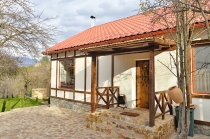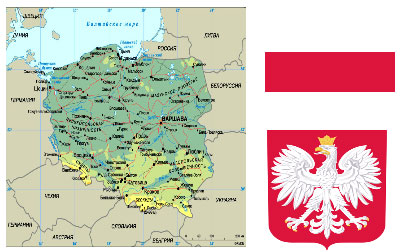
Marriott Tsaghkadzor
The hotel complex "Marriott Tsaghkadzor" offers a comfortable stay in the fresh air of Tsaghkadzor,...
Golden Palace Resort
"Golden Palace Resort-Spa" is the only officially recognized 5-star hotel in Tsakhkadzor, in...
Elegant
Elegant" hotel has stylish rooms where the guests can enjoy picturesque view of mountains and...
Villa Jrhogher
"Villa Jrhogher" is situated in the heart of Dilijan’s forests and is a perfect choice for a small group of friends, colleagues or family members to host up to 10 guests. Free private parking...Poland

| Capital | Warsaw |
| Area | 312 685 km |
| Population | 38 167 000 people |
| Officai ianguage | Polish |
| Currency | Polish zioty |
| Climate | summer` +18°C winter` +4°C |
| Recommended type of holiday | sightseeing |
About country
One of Europe's most underrated countries, Poland offers a huge amount for travellers of all stripes - from the wild scenery of its mountainous south, with its great skiing and hiking, to the stunning old towns of Cracow, Zamosc and Gdansk and the wilderness of the Bialowieza National Park and the Great Malsurian Lakes in the country's north.
Modernising and changing fast, the Polish capital Warsaw was almost totally destroyed during WWII, when it was home to Europe's most notorious ghetto. Today the city is a combination of Soviet and contemporary, with a painstakingly recreated old town and an upbeat, progressive population. Yet most tourists head straight for the country's biggest draw, Cracow, the country's royal capital and a stunningly preserved architectural marvel that has somehow managed to survive the many wars that have used Poland as a battle ground.



Sightseeing
It may be hard to convince people, but Poland really boasts some of the very best beaches in northern Europe, especially the resorts of the Pomeranian coast, such as Kolobrzeg (large and fashionable) or Leba (with a beach of fabulous white sand). The beach connects to the Slowinski National Park (www.slowinskipn.pl), known for its giant 'wandering sand dunes' which can shift several metres each year.
The Bialowieza National Park (www.bpn.com.pl) is the last major refuge of the European bison as well as being home to many other rare forest-dwelling species and trees over 400 years old. Nature trails, cycling and exploring with a ranger are on offer.
The best way to explore the Brodnica or Mysliborz lakelands, or the rivers Brda, Czarna Hancza and Obra is by canoe.
The manor house where Frederick Chopin (www.infochopin.pl) was born in Zelazowa Wola, 53km (32 miles) west of Warsaw makes for a great day trip. Attractions include an attractive park, summertime recitals and 19th-century instruments and furniture.



Traditions
Christmas in Poland is a major annual celebration, as in most countries of the Western world. The observance of Christmas developed gradually over the centuries, beginning in ancient times; combining old pagan customs with the religious ones introduced after the Christianization of Poland by the Catholic Church. Later influences include mutual permeating of local traditions and various folk cultures. Unlike in many other Christian countries, St. Nicholas does not play a major role in Polish Christmas, but instead, is celebrated on his Saint feast day of December 6.
Easter Monday is the day after Easter Sunday and is celebrated as a holiday in some largely Christian cultures, especially Roman Catholic and Eastern Orthodox cultures. Easter Monday in the Roman Catholic liturgical calendar is the second day of the octave of Easter Week.
Formerly, the post-Easter festivities involved a week of secular celebration, but this was reduced to one day in the 19th century. Events include egg rolling competitions and, in predominantly Roman Catholic countries, dousing other people with water which traditionally had been blessed with holy water the day before at Easter Sunday Mass and carried home to bless the house and food.
Fat Thursday (German Fetter Donnerstag, Schmutziger Donnerstag, or in areas where carnival is celebrated Weiberfastnacht; Greek Τσικνοπέμπτη (Tsiknopempti); Polish Tłusty czwartek) is a traditional Polish, Greek and German feast marking the last Thursday before Lent and is associated with the celebration of Carnival. Because Lent is a time of fasting, the next opportunity to feast would not be until Easter. It is similar to, but should not be confused with, the French festival of Mardi Gras ("Fat Tuesday"). Traditionally it is a day dedicated to eating, when people meet in their homes or cafés with their friends and relatives and eat large quantities of sweets, cakes and other meals forbidden during Lent. Among the most popular all-national dishes served on that day are pączki or berliner, fist-sized donuts filled with rose marmalade, and faworki, French dough fingers served with lots of powdered sugar.



Cuisine
Food is another and perhaps rather surprising draw to Poland. Often written off as stodgy and greasy, Polish food is actually some of Eastern Europe's best - and you've not really been to Poland until you've had a plate full of pierogi (delicious boiled dumplings) and washed it down with one of Poland's many fine beers.
<br/>
Popular local ingredients include dill, marjoram, caraway seeds, wild mushrooms and sour cream, which is frequently added to soups, sauces and braised meats. Soups play an important part at mealtimes and are usually rich and very thick. Barszcz (beetroot soup), however, runs thin and clear and is often served in cups with small hot pasties stuffed with meat or cabbage. There are several fish dishes using trout, carp and herring. Pastries, such as szarlotka (apple cake), packi (jelly doughnuts) and makowiec (poppy seed cake) can be bought at a cukiernia. Note that big cities offer a selection of other world cuisines.





